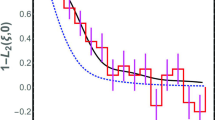Abstract
To understand the nature of garments as worn, it is essential to model and animate the formation process of garment wrinkles. Because the number of components making up a garment is extremely high, simulating its behavior under dynamic constraints requires a very large amount of computation, and the result is difficult to analyze and understand. We show that exploiting geometric features of wrinkles can greatly increase the understandability of the computed result, while not much increasing the amount of computation needed. We present the modeling primitives of garment wrinkles, which can suitably represent geometric features of wrinkles under the dynamic constraints. Extracting geometric features based on singularity theory enables us to model the qualitative shape change of wrinkles. The formation process of wrinkles is animated by using these primitives.
Similar content being viewed by others
References
Arnold VI (1986) Catastrophe theory, 2nd edn. Springer, Berlin Heidelberg New York
Bar AH (1984) The global and local deformations of solid primitives. Comput Graph (Proc SIGGRAPH) 18 (3):21–29
Chillingworth D (1975) The catastrophe of a buckling beam. In: Manning A (ed) Dynamical systems-Warwick. Lecture notes in mathematics, vol 468. Springer, Berlin Heidelberg New York, pp 86–91
Kergosien YL (1981) Topologie différentielle. Comptes Rendus 291 (1):929–932
Kergosien YL (1983) Medical exploration of some rhythmic phenomena. In: Cosnard M, Demongeot J, Le Breton A (eds) Proc CIRM colloquium on rhythms in biology. Lecture notes in biomathematics. Springer, Berlin Heidelberg New York 49:32–49
Kunii TL, Gotoda H (1990) Modeling and animation of garment wrinkle formation processes. In: Magnenat-Thalmann N, Thalmann D (eds) Computer Animation '90. Springer, Berlin Heidelberg New York, pp 131–147
Platt JC, Barr AH (1988) Constraint methods for flexible models. Comput Graph (Proc SIGGRAPH) 22 (4):279–288
Schweikert DG (1966) An interpolation curve using a spline in tension. J Math Phys 45:312–317
Terzopoulos D, Fleisher K (1988) Deformable models. The Visual Computer 4:306–331
Terzopoulos D, Platt JC, Barr AH, Fleisher K (1987) Elastically deformable models. Comput Graph (Proc SIGGRAPH) 21 (4):205–214
Thom R (1972) Stabilité structurelle et morphogénèse. Benjamin, New York
Weil J (1986) The synthesis of cloth objects. Comput Graph (Proc SIGGRAPH) 20 (4):49–54
Wyvill G, McPheeters C, Wyvill B (1986) Data structure for soft objects. The Visual Computer 2:227–242
Zeeman EC (1977) Catastrophe theory: selected papers (1972–1977). Addison-Wesley, Reading, Mass
Zienkiewicz OC (1977) The finite element method, 3rd edn. McGraw-Hill, London
Author information
Authors and Affiliations
Rights and permissions
About this article
Cite this article
Kunii, T.L., Gotoda, H. Singularity theoretical modeling and animation of garment wrinkle formation processes. The Visual Computer 6, 326–336 (1990). https://doi.org/10.1007/BF01901019
Issue Date:
DOI: https://doi.org/10.1007/BF01901019




